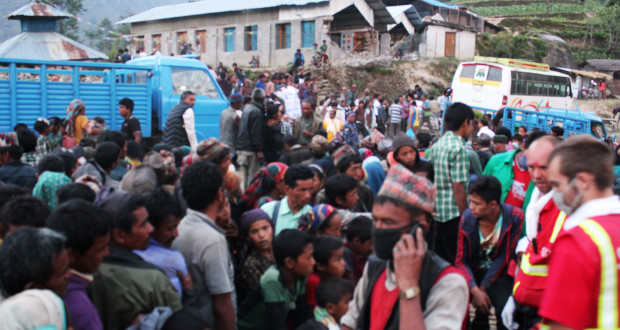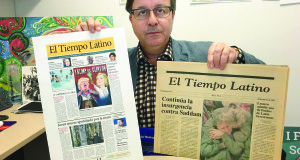One evening last spring, Anil Pandey was alone in his home office at about 11 p.m., catching up with a close friend in Nepal via Facebook chat when his newsfeed began to fill with posts about an earthquake.
From those updates, rife with exclamations of “Oh, my God,” Pandey learned of the 7.8 magnitude earthquake that struck Nepal on April 25. Although the disaster zone was thousands of miles from his home in El Sobrante, California, Pandey found out about the earthquake within 20 minutes of its occurrence.
Harihar Dahal, 43, of Sunnyvale, California, heard about the earthquake from his nephew in Kathmandu. The nephew was typing a Facebook post from the doorway of his house as people were running out of the crumbling buildings.
As his Facebook friends in Nepal uploaded pictures and posted descriptions of the destruction, Dahal viewed the changes in the landscape of his home country nearly in real time.
“Facebook was the best medium for us to get information,” Dahal said. “Twitter, Facebook, WhatsApp, all these social media are the most powerful.”
The earthquake and a second tremor in May killed more than 8,600 people and injured twice that number, according to an incident report by Nepal Disaster Risk Reduction Portal. Many Nepalis living in the Bay Area received news of the earthquakes from Facebook — not from traditional media outlets, such as newspapers and broadcast news reports.
Pandey, 51, is among a growing number of people who find their news and ethnic content from Facebook and other social media platforms. He is chairman for Motherland Nepal, a non-profit social and cultural organization, and the honorary public relations representative of the Nepal Tourism Board for San Francisco.
A new study published by Pew Research Center in association with the John S. and James L. Knight Foundation shows that Facebook is growing rapidly as a source of news. Sixty-three percent of Facebook users surveyed reported getting news from the social networking site. That is a notable increase from 2013, when 47 percent of Facebook users considered it a news source. The trend is independent of overall site usage, which has been stable since 2013.
Daniel C. Tsang, a librarian in Asian American studies, political science and economics at the University of California-Irvine, said accessibility and affordability contribute to immigrant communities’ use of social media for news.
“It’s become the norm for people of color and immigrant groups to first use Facebook, for instance, to communicate,” Tsang said.
Tsang followed the Umbrella Movement that occupied city streets in his native Hong Kong from September to December 2014 through Facebook. Activists leading the political protests used the site to communicate directly with their audience.
In the aftermath of the earthquake in Nepal, media outlets in the Bay Area did not have access to information about the disaster. Pandey turned to Facebook, phone calls and accounts from Nepali journalists to stay informed.
“Actually, I was the main source for Bay Area TV and newspaper,” Pandey said. “They don’t know anything much more than us because we have a direct connection through Facebook and Viber.”
Pandey and others from Motherland Nepal created a Facebook post and tagged those they knew were safe in Nepal, or asked them to tag themselves. Without Internet access, some were slow to respond. Pandey also called members of the Nepali community in the Bay Area to check on their relatives in Nepal.
“We did a lot of work for a couple of days, making sure everyone is safe,” Pandey said.
Facebook provides relief for families
Facebook’s Safety Check aided their efforts. The feature, launched in October 2014, was developed after the 2011 earthquake and tsunami in Japan. It sends users a push notification if the current location listed on their profile is in a crisis area. The Safety Check notification asks the user, “Are you safe?” Users can post “I’m safe,” or “I’m not in the area,” in response, and also account for others whom they know are safe. Users can filter their friends list to determine who has been marked safe and who has not responded.
On April 30, Facebook CEO Mark Zuckerberg posted on his timeline about the efficacy of Safety Check after the first earthquake in Nepal.
“We activated Safety Check and more than 7 million people in the area have been marked as safe. More than 150 million friends were notified and those updates let people rest easier and relief efforts remain focused,” he wrote.
With Nepal’s population of 29 million, that equates to about one-fourth of Nepalis being accounted for by Safety Check.
Nevertheless, Pandey said electricity outages and disconnected phone lines prevented him from reaching some of his relatives in Nepal for almost a week.
After the first earthquake, Pandey and Motherland Nepal took a four-person rescue team to the devastated country. They provided first aid services, survival supplies and began rebuilding caved-in roofs and shaken foundations.
Motherland Nepal also published articles about the earthquake and the rescue team’s experiences in Nepali and English. The stories are a product of organization’s news outlet, which covers Nepali events and issues in the Bay Area.
For Sapana Sharma, 37, of El Cerrito, California, coverage of the earthquake was overwhelming.
Sharma typically relies on online news published in Nepal instead of local and national U.S. media coverage of South Asian events.
With infrastructure disabled after the quakes, Nepalese media sources were publishing news through Facebook instead of their own websites, so Sharma looked there for updates.
Sharma, who immigrated from Kathmandu to the United States in 2002, has a brother, uncles, aunts and cousins in Nepal. Facebook Messenger was the only way she could contact those relatives and her cousin in neighboring India. When Viber and Twitter were ineffective, Facebook was reliable.
“And that is one of the reasons I am so thankful for Facebook,” Sharma said.
 VOICES Publishing from the AAJA National Convention
VOICES Publishing from the AAJA National Convention








